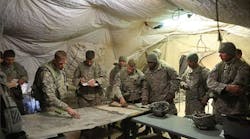EGLIN AFB, Fla., 9 Jan. 2012.Munitions guidance experts at the Raytheon Co. Space and Airborne Systems segment in El Segundo, Calif., will design and demonstrate navigation and guidance technologies that can keep new generations of deep-penetrating bombs and missiles on target in conditions where signals from Global Positioning System (GPS) satellite satellites are degraded or unavailable. Raytheon is doing the work under terms of an $11 million contract awarded Friday by the U.S. Air Force Research Laboratory's Munitions Directorate at Eglin Air Force Base, Fla.
Raytheon will develop GPS-degraded munitions guidance technology as part of the Air Force High Velocity Penetrating Weapon program, which seeks to develop technologies for a future rocket-boosted 2000-pound weapon with the penetration capability of a 5000-pound gravity-dropped bomb that could be carried in the weapons bay of the Lockheed Martin F-35 Lighting II joint strike fighter and other fighter-bombers.
U.S. military officials are interested in developing deep-penetrating weapons such as the High Velocity Penetrating Weapon and the Massive Ordnance Penetrator (MOP) to attack and destroy deeply buried research facilities and weapons laboratories in areas such as Iran, which intelligence experts suspect is developing nuclear weapons from the supposed safety of underground bunkers.
For their part, Raytheon engineers will develop guidance to provide maximum penetration for a future High Velocity Penetrating Weapon, with the ability to overcome GPS-degraded environments and direct the deep-penetrating weapon to impact angles sufficient to destroy hard, deeply buried facilities.
Raytheon experts will explore weapons-guidance technologies for anti-jam GPS, angle-of-attack sensing, guidance law and autopilot, and RF seeker and guidance techniques that could support the High Velocity Penetrating Weapon's accuracy.
Air Force weapons designers are particularly interested in RF seekers, as well as multilateration and offset tracking guidance that provide sufficient information for guidance alignment of the weapon before and during boost. Raytheon also will develop munitions guidance able to provide off bore-sight tracking of features and derive guidance estimates for closed-loop offset guidance. Other technology development involved in the High Velocity Penetrating Weapon program are warheads, propulsion, and systems integration.
Raytheon will do the work in El Segundo, Calif., and should be finished by the end of 2013. For more information contact Raytheon Space and Airborne Systems online at www.raytheon.com/businesses/rsas, or the Air Force Research Laboratory Munitions Directorate at www.eglin.af.mil/units/afrlmunitionsdirectorate.



